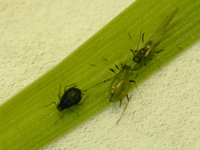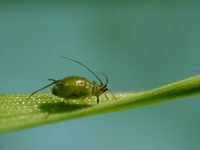Note on May and June-Plant pathogens find unique ways of moving from host to host (dispersal). They may use water, vectors, wind, or a combination of these methods. In these two news items, we are focusing on two examples of a unique dispersal method used by some pathogens or their vectors, riding the wind currents (low level jet winds) from the Southern to the Northern Plains. This movement will be occurring through Texas, Oklahoma, Kansas, Nebraska, South Dakota, North Dakota, and the states which border them as you are reading these articles. Watch for evidence or news of these pathogens or other pathogens that ride the wind in your home area.
Cereals, such as wheat (Triticum aestivum), barley (Hordeum vulgare), oats (Avena sativa), and rye (Secale cereale), are major crops in the Great Plains of North America and make up a large proportion of the almost two billion metric tons of cereals consumed annually by humans and livestock throughout the world. Pathogens, insects, and weeds impact cereal production, causing millions of bushels in losses each year. Barley yellow dwarf virus (PAV and RMV strains) and Cereal yellow dwarf virus (RPV strain) are two major viral pathogens affecting these crops. They are transmitted by various species of aphids-small [about 1/16 inch (2 mm) long] soft-bodied insects that suck the sap from plant stems or leaves. The most prominent species, which transmit cereal viruses, are the bird cherry-oat aphid (Rhopalosiphum padi), English grain aphid (Sitobion avenae), greenbug (Schizaphis graminum), and corn leaf aphid (Rhopalosiphum maidis) (Fig. 1 and 2). Cereal aphids may damage cereal crops by feeding, but their major impact is from virus transmission. In the northern Great Plains, aphids are present every year but are limited in their ability to survive the harsh winters. Thus, each spring, re-establishment of aphids in the northern Plains depends largely upon an influx from cereal fields in the southern Great Plains. In years with the right conditions, the influx of cereal aphids is quite dramatic, resulting in extremely high incidence of virus-infected plants.

Figure 1. |

Figure 2. |
How do these aphids move back into the northern Plains and increase to dramatic levels? Two factors are required. First, aphids must have established large populations on cereal crops in the southern Plains states such as Texas and Oklahoma. Second, weather at the time of aphid population build-up must favor the occurrence of low-level jet winds to transport cereal aphids from the southern to the northern Plains. A low-level jet wind is defined as a stream of fast-moving air in the 1000 m of atmosphere closest to the earth. Low-level jet winds often originate on cloudless nights following bright sunny afternoons when high pressure lies over the eastern or southeastern states and low pressure dominates the southern or central Rocky Mountains. Jet winds can be substantial, sometimes blowing up to 50 miles per hour for 1 to 3 days at a time.
Populations of cereal aphids typically consist of winged and wingless individuals. The proportion of winged individuals in a population increases as aphids become crowded on leaves and stems and as virus-infected plants weaken. When these winged aphids fly on late afternoons or evenings in which low-level jet winds arise, they may be transported several hundred miles and fall out in cereal crop fields in northern states. The pattern of fallout is considered accidental and may be localized to a few counties or extensive enough to include portions of several states. In areas of fallout, the incidence of aphid-infested plants rises dramatically followed by a high incidence of yellow dwarf diseases. Heavy aphid infestations and high incidence of viral diseases in cereal crop fields in the northern Plains actually occur somewhat infrequently, perhaps only once in ten years or so on average. Particularly large peaks in aphids and viral diseases in cereal crops of the northern Plains include outbreaks in Minnesota and several other states in 1959, Iowa in 1975, Illinois and other upper Midwest states in the early 1980s, and portions of Minnesota, North Dakota and South Dakota in 1999.
Most years, aphid population build-ups don't coincide with low-level jet winds, but aphids are still carried northward each spring by lighter, less sustained southerly winds. In this case, aphid transport is much slower and less dramatic, as aphid populations move in "stair-step" fashion progressing from crop fields in southern states to northern ones. Lighter aphid infestations and lower incidence of virus in cereal fields are associated with these conditions, but still may impact cereal crop production.
The following websites contain more information about related subjects:
- To learn more about barley yellow dwarf, try the Plant Disease Lesson-Barley yellow dwarf virus available here at the APS Education Center.
- Introduction to Plant Viruses (http://www.dpvweb.net/intro/index.php) at the Descriptions of Plant Viruses sponsored by the Association of Applied Biologists provides information on what are viruses, their importance, transmission, and classification.
- Information about aphids, their biology, and their role as plant pests can be found at these three sites:
- For information on wheat, focus on the Wheat Page sponsored by K-STATE Research and Extension. It has Adopt a Wheat Field that takes wheat from its planting until it is milled and baked, Kid's Field Day-a virtual site about agronomy, and Wheat Watch that features current wheat growth.
|
MATH QUIZ
- You have a wheat farm in the Northern Plains that is 1 km x 1 km. A jet stream (1 km wide x 0.3 km thick) is passing over your farm at 50 km/hr. The jet stream contains enough aphids to produce a density of 4,800 aphids in 106 m3 of air. At the northern edge of your farm, there is an unusually strong cold front. As the jet meets it, all the aphids drop out of the jet and fall on your farm. In five hours, how many aphids will fall on your wheat farm?
- If 1% of the aphids are carrying BYDV, how many viruliferous aphids will fall on your farm?
|
|
Our Answers
- The jet stream will pass over your farm for 5 hrs at 50 km/hr. This gives a length of 250 km. Next, convert the distance to meters and find the volume of the jet stream passing over your farm.
(1 x 103 m) x (3 x102 m) x (2.5 x 105 m) = 7.5 x 1010 m3
Then, find the number of 106 m3 volumes in the volume of the jet stream.
7.5 x 1010 m3 / 106 m3 / air volume = 7.5 x 104 volumes of air
Now, multiply the number of air volumes by the number of aphids per volume to find the total number of aphids.
(7.5 x 104 volumes of air) x (4.8 x 103 aphids) = 3.6 x 108 aphids falling on your field *
- To find the per cent of viruliferous aphids, convert the percentage to a decimal and multiply the total number of aphids by this.
(1 x 10-2 ) x (3.6 x 108 aphids) = 3.6 x 106 viruliferous aphids falling on farm
*In this example, we utilized the largest aphid number that we found reported. In real life, every aphid would not fall on one field, some aphids would die during the journey and descent, some would die before feeding, and not all aphids would carry virus. |
